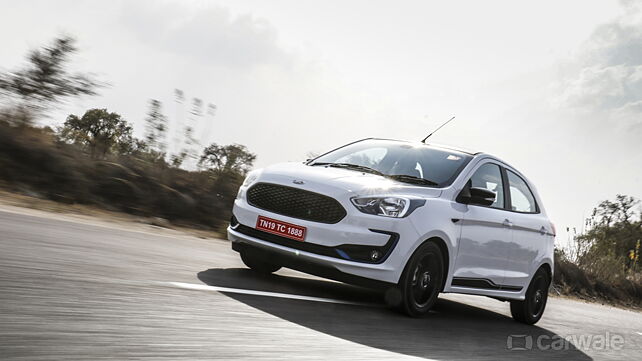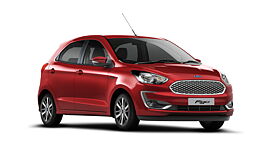What is it?

Why I would buy it?
Competitive pricing, great ride and handling balance, strong diesel engine
Why I would avoid it?
Some important features are missing, interior quality could have been better
The car you see on these pages is the midlife facelift of the Ford figo. Armed with cosmetic and mechanical upgrades, the Figo is better than ever before and is one of the finest hatchbacks you can buy in the country. Read further to know why.
There are no sheet metal changes on the new Figo. Instead it has undergone small updates which make the car look fresher and more modern. The changes are mainly to the front. The new grille is more protruding than before and makes the front look bolder and more attractive.

There are hardly any changes to the profile and even the rear is very similar except for the chiseled new bumper. Unlike the old car, the top Titanium + is replaced by the BLU variant which gets you a black roof, mirrors and wheels. It also has a boomerang shaped fog lamp surround that is finished in Blue. These contrasting additions are to our liking, but if you want to buy a normal looking Figo then you have to buy the lower titanium variant.
How is it on the inside?

If you find it hard to see the changes on the outside, we bet you won't say the same once you step inside and that is mainly thanks to the new 7 inch touch infotainment system. This makes the dashboard look cleaner thanks to lesser number of physical buttons. The infotainment system isn't the Sync 3 you find on the Freestyle and the Aspire. Which isn’t such a big problem until you realise that there aren’t any phone mirroring features. So no android auto, no apple CarPlay and no mirror link either, which has now become a norm at this price range.

The Blu variant, on the inside, comes with blue accents on the door pads and contrasting blue stitching on the seats. Thankfully it doesn’t look over the top. In terms of quality, there are no soft touch plastics in the cabin and even the graining looks a tad cheap compared to the Grand i10 or even the Swift. However, this isn’t a deal breaker and on its own, the quality is acceptable. In terms of seating comfort, it comes with the same space as the old car and the front seats are wide enough and comfortable. The rear,seat doesn’t have the same amount of space unlike those of its competitors, but still it is quite comfy with decent thigh support and adequate knee room. Unlike the old car, the new Figo also gets adjustable rear headrests, which is a great addition in terms of safety and comfort.

The boot, at 257 litres, is large enough and the rear seat can be folded for added space. A split folding rear seat though would have been welcome. There is a good amount of storage space upfront with large door pockets and a number of small storage spaces. But at the rear you feel short changed as there is very little storage except for the seatback pockets and a single cup holder.

In terms of equipment, the Figo comes well equipped. It has premium features like automatic headlamps and rain sensing wipers on the top Blu variant. Another thing to point out is that the touchscreen infotainment system comes as standard in all three variants. It does miss out on features like LED headlamps, daytime running lamps and phone mirroring features on the infotainment system which is offered on rival products. But it more than makes up for that, by offering best-in-class 6 airbags on the top variant.
How does it drive?

The Figo is powered by a pair of brand-new petrol engines and the tried and tested 1.5 litre diesel from the old car. In this review, we will speak about the diesel and the petrol manual variant, which is a 1.2 litre three cylinder motor from Ford’s Dragon family of engines.

Starting with the petrol, the 1194cc petrol engine produces best-in-class 95bhp and 120Nm of torque. It is a modern motor with all-aluminium construction and is much lighter than the older unit. Besides promising better performance, Ford also claims that it offers much better fuel economy. Thumb the starter button and this three cylinder motor surprises you with its smooth and refined idle. Some amount of vibrations can be felt at idle, but the engine smoothens out as soon as the car starts moving. And as long as you don’t rev it hard, this motor is pretty silent. Compared to the old engine, this motor definitely packs more punch from the get go. Although the motor doesn’t have a strong bottom end, once past 3000rpm it feels responsive and the motor gets a second wind around 5200rpm. The performance on the highway though, feels modest, especially with a full load of passengers. Special mention must also go to the new manual gearbox, which has a positive action and the short throws make it a joy to use. Although performance has improved over the old car, it still doesn’t feel as strong as the K-Series engine in the Swift. The fact that the Figo weighs much more than the Maruti doesn’t help its performance either.

Coming to the diesel, it's still a highlight of this car. As soon as you start the engine you realize that this 1498cc engine is quite refined. This common-rail diesel churns out a very impressive 99bhp and 216Nm of max pulling power. Power delivery is pretty seamless and one can barely feel the turbo kicking in. There’s a gentle surge at around 1700rpm, followed by a strong push till the 3800rpm past which it’s best to upshift. What’s also good is that the engine has a fairly strong push so the gearbox doesn’t have to be constantly worked to make quick progress. Even if you have to shift, Ford has plonked in a new manual transmission that is smoother and more positive than before, which in turn elevates the driving experience further.
The Figo also comes with a petrol automatic which a new three cylinder engine from the dragon engine family. It is mated to a 6-speed torque converter and like the old car will come only in the mid spec Titanium variant.

When it comes to ride and handling, the Ford Figo remains as strong as before. The steering is direct and it is eager to change direction too. The Figo feels a little soft initially and body roll is gentle but not excessive. In fact, the suppleness doesn’t come at the expense of stability and even at high speeds on an undulating surface, the Figo feels rock solid. In terms of comfort too, this Ford shows great composure, whether it be at high or low speeds and the ride quality is flat and it absorbs the worst of road conditions with aplomb. Even the brakes feel strong and the pedal feel is sharp yet progressive.
Should I buy one?

Overall the small upgrades has made the Figo a good overall package. More importantly, Ford has addressed the problem of the old car with the new petrol engine which is more powerful and the dashboard now looks modern and up to date. When you combine that with the core Figo strengths like comfortable ride and fun handling it makes for a very competitive hatchback. What adds to the feel good factor is the 5 year optional warranty and it being the only car to offer six airbags in it's segment. On the downside, there are some important features missing. For example, you don't get daytime running lamps and also the infotainment system lacks phone mirroring features which could be deal breakers in an otherwise competitive package. The trump car though is the price, as Ford has managed to price it really well as it undercuts most of its competition. So, is the new Figo armed with a competitive price tag, better than the competition? We will only know that when we drive them back to back. But one thing is certain - the new Figo is definitely back in the game.
Where does it fit in?

The 2019 Ford Figo petrol manual is priced in the range of Rs 4.99 lakhs to Rs 7.40 lakhs (ex-showroom Delhi) and the diesel manual is priced in between Rs 5.95 lakhs to Rs 7.74 lakhs (ex-showroom Delhi) which makes it one of the most affordable cars in its class. It competes with the likes of the Hyundai Grand i10 and the Maruti Suzuki Swift.
Pictures by: Kapil Angane
































